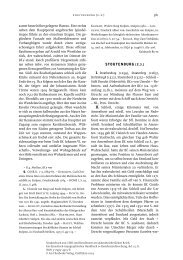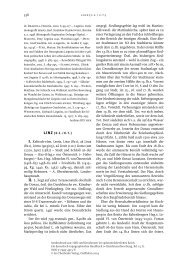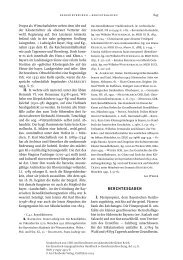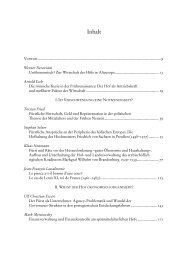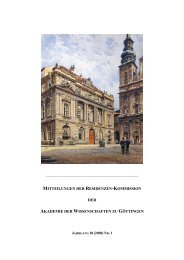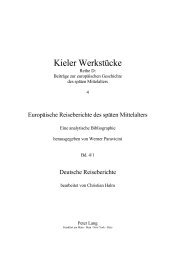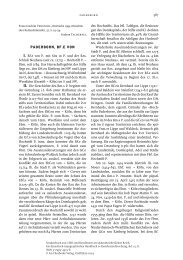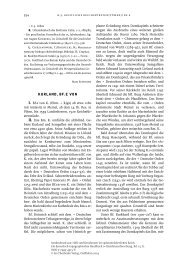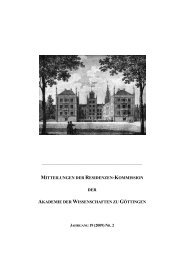MITTEILUNGEN DER RESIDENZEN-KOMMISSION DER ...
MITTEILUNGEN DER RESIDENZEN-KOMMISSION DER ...
MITTEILUNGEN DER RESIDENZEN-KOMMISSION DER ...
Erfolgreiche ePaper selbst erstellen
Machen Sie aus Ihren PDF Publikationen ein blätterbares Flipbook mit unserer einzigartigen Google optimierten e-Paper Software.
of speakers presenting their papers themselves, however, the respective section chairs summarized<br />
and presented their findings. The speakers were then given an opportunity to clarify<br />
their positions both in direct response to these summaries and in the course of the ensuing<br />
general discussion (only in the first session was it necessary to revert to the traditional format<br />
because of the chair’s last-minute cancellation). To give participants the opportunity to prepare<br />
for the discussions, all papers were made available through the GHIL’s website before the<br />
conference.<br />
In his introductory lecture, ‚Hofkultur – Probleme und Perspektiven‘, Joachim Ehlers<br />
(Berlin) gave an overview of the state of knowledge about the position of the court in the<br />
political, social, cultural, and economic structure of the High Middle Ages. He emphasized<br />
the practical significance of the deliberate creation of a courtly milieu, identified shortcomings<br />
in previous research, and indicated directions that future research might take. The first<br />
session, ‚Communal Action: Between Service, Feast, and Leisure‘, looked not only at how<br />
the elevated courtly way of life was organized, but also at how it was experienced. In his<br />
paper on ‚Hofämter und Hofkultur an Fürstenhöfen des Hochmittelalters‘ Werner Rösener<br />
(Gießen) discussed the development and functionalization of court culture at a number of<br />
specific princely courts in the Holy Roman Empire during the twelfth and thirteenth centuries,<br />
concentrating in particular on court offices and court festivals. In the High Middle Ages,<br />
he summed up, this cultural form was concentrated on the person of the ruler and served<br />
primarily as a vehicle for his self-presentation and to increase his prestige among the circle of<br />
his social equals. In addition, the princely court and its cultural forms, which were shaped by<br />
the culture of the knights, served to bring together vassals and ministeriales from different<br />
areas. The increased integration and centralization of rule to which this contributed compensated<br />
for the decentralized power structures of the High Middle Ages. Court offices served<br />
two main purposes: they could meet the practical needs of the court administration, or they<br />
could have representative functions. For a long time, the royal court provided the model for<br />
court organization and knightly cultural forms at the German princely courts of the High<br />
Middle Ages. By contrast, the Polish-Lithuanian elective monarchy, established in 1572, had<br />
only moderate financial resources and did not allow for a strong central power. Under these<br />
conditions, the election and coronation ceremonies at the beginning of each new reign, as<br />
well as the ceremonies surrounding the burial of the previous ruler, were of crucial importance<br />
and integrated the whole of society, as Almut Bues (Warsaw) emphasized in her paper,<br />
entitled ‚Le manque de couleurs & d’imagination pour y bien reüssir. The Integrative Power<br />
and Political Use of Festival in an Elective Monarchy: Poland-Lithuania in the Sixteenth<br />
Century‘. The keeping of these ancient dynastic traditions served to give Poland-Lithuania’s<br />
elective monarchy the fiction of legitimacy, continuity, and stability.<br />
In her paper ‚Les cours hors la cour: les manifestations du luxe aristocratique dans le royaume<br />
de Louis XIV‘, Katia Béguin (Paris) expressly opposed the ‚Versaillo-centrism‘ which<br />
dominates French research on the court. She spoke about the residences of the high aristocracy<br />
that surrounded the royal court like satellites in the second half of the seventeenth century.<br />
These did not, she suggested, represent mere fall-back positions for a politically emasculated<br />
aristocracy. Although their presumed advantages over Versailles were celebrated, along with<br />
the wealth, taste, and creativity of the lord of the manor, with the assistance of a festive culture<br />
that was specific to these aristocratic seats, they did not express political opposition to the<br />
monarch. Rather, these were deliberate attempts to enhance the prestige of one’s own residence<br />
in the eyes of a foreign and domestic public, in open competition with one’s social<br />
equals. Wolfgang Wüst (Erlangen-Nuremberg), however, speaking on ‚Luxus oder Sparzwang?<br />
Höfisches Leben im frühmodernen süddeutschen Kleinstaat: Ansbach-Bayreuth<br />
(Hohenzollern) und Augsburg-Dillingen (Bischöfe) im Vergleich‘, cast doubt on the notion<br />
32




